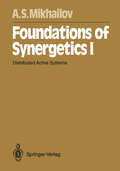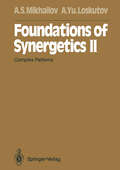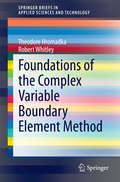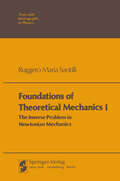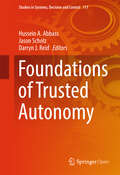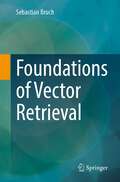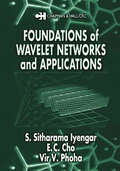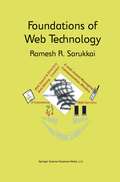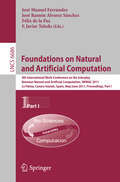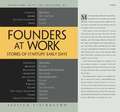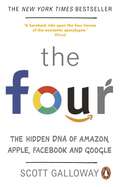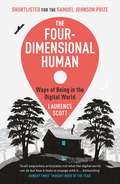- Table View
- List View
Foundations of Synergetics I: Distributed Active Systems (Springer Series in Synergetics #51)
by Alexander S. MikhailovThis book gives an introduction to the mathematical theory of cooperative behavior in active systems of various origins, both natural and artificial. It is based on a lecture course in synergetics which I held for almost ten years at the University of Moscow. The first volume deals mainly with the problems of pattern fonnation and the properties of self-organized regular patterns in distributed active systems. It also contains a discussion of distributed analog information processing which is based on the cooperative dynamics of active systems. The second volume is devoted to the stochastic aspects of self-organization and the properties of self-established chaos. I have tried to avoid delving into particular applications. The primary intention is to present general mathematical models that describe the principal kinds of coopera tive behavior in distributed active systems. Simple examples, ranging from chemical physics to economics, serve only as illustrations of the typical context in which a particular model can apply. The manner of exposition is more in the tradition of theoretical physics than of in mathematics: Elaborate fonnal proofs and rigorous estimates are often replaced the text by arguments based on an intuitive understanding of the relevant models. Because of the interdisciplinary nature of this book, its readers might well come from very diverse fields of endeavor. It was therefore desirable to minimize the re quired preliminary knowledge. Generally, a standard university course in differential calculus and linear algebra is sufficient.
Foundations of Synergetics I: Distributed Active Systems (Springer Series in Synergetics #51)
by Alexander S. MikhailovThis book gives an introduction to the mathematical theory of cooperative behavior in active systems of various origins, both natural and artificial. It is based on a lecture course in synergetics which I held for almost ten years at the University of Moscow. The first volume deals mainly with the problems of pattern formation and the properties of self-organized regular patterns in distributed active systems. It also contains a discussion of distributed analog information processing which is based on the cooperative dynamics of active systems. The second volume is devoted to the stochastic aspects of self-organization and the properties of self-established chaos. I have tried to avoid delving into particular applications. The primary intention is to present general mathematical models that describe the principal kinds of coopera tive behavior in distributed active systems. Simple examples, ranging from chemical physics to economics, serve only as illustrations of the typical context in which a particular model can apply. The manner of exposition is more in the tradition of theoretical physics than of mathematics: Elaborate formal proofs and rigorous estimates are often replaced in the text by arguments based on an intuitive understanding of the relevant models. Because of the interdisciplinary nature of this book, its readers might well come from very diverse fields of endeavor. It was therefore desirable to minimize the re quired preliminary knowledge. Generally, a standard university course in differential calculus and linear algebra is sufficient.
Foundations of Synergetics II: Complex Patterns (Springer Series in Synergetics #52)
by Alexander S. Mikhailov Alexander Yu. LoskutovThis textbook is based on a lecture course in synergetics given at the University of Moscow. In this second of two volumes, we discuss the emergence and properties of complex chaotic patterns in distributed active systems. Such patterns can be produced autonomously by a system, or can result from selective amplification of fluctuations caused by external weak noise. Although the material in this book is often described by refined mathematical theories, we have tried to avoid a formal mathematical style. Instead of rigorous proofs, the reader will usually be offered only "demonstrations" (the term used by Prof. V. I. Arnold) to encourage intuitive understanding of a problem and to explain why a particular statement seems plausible. We also refrained from detailing concrete applications in physics or in other scientific fields, so that the book can be used by students of different disciplines. While preparing the lecture course and producing this book, we had intensive discussions with and asked the advice of Prof. V. I. Arnold, Prof. S. Grossmann, Prof. H. Haken, Prof. Yu. L. Klimontovich, Prof. R. L. Stratonovich and Prof. Ya.
Foundations of Synergetics II: Chaos and Noise (Springer Series in Synergetics #52)
by Alexander S. Mikhailov Alexander Yu. LoskutovThe second edition of this volume has been extensively revised. A different version of Chap. 7, reflecting recent significant progress in understanding of spatiotempo ral chaos, is now provided. Much new material has been included in the sections dealing with intermittency in birth-death models and noise-induced phase transi tions. A new section on control of chaotic behavior has been added to Chap. 6. The subtitle of the volume has been changed to better reflect its contents. We acknowledge stimulating discussions with H. Haken and E. Scholl and are grateful to our colleagues M. Bar, D. Battogtokh, M. Eiswirth, M. Hildebrand, K. Krischer, and V. Tereshko for their comments and assistance. We thank M. Lubke for her help in producing new figures for this volume. Berlin and Moscow A. s. Mikhailov April 1996 A. Yu. Loskutov Preface to the First Edition This textbook is based on a lecture course in synergetics given at the University of Moscow. In this second of two volumes, we discuss the emergence and properties of complex chaotic patterns in distributed active systems. Such patterns can be produced autonomously by a system, or can result from selective amplification of fluctuations caused by external weak noise.
Foundations of Systems Biology: Using Cell Illustrator and Pathway Databases (Computational Biology #13)
by Masao Nagasaki Ayumu Saito Atsushi Doi Hiroshi Matsuno Satoru MiyanoToday, as hundreds of genomes have been sequenced and thousands of proteins and more than ten thousand metabolites have been identi?ed, navigating safely through this wealth of information without getting completely lost has become crucial for research in, and teaching of, molecular biology. Consequently, a considerable number of tools have been developed and put on the market in the last two decades that describe the multitude of potential/putative interactions between genes, proteins, metabolites, and other biologically relevant compounds in terms of metabolic, genetic, signaling, and other networks, their aim being to support all sorts of explorations through bio-data bases currently called Systems Biology. As a result, navigating safely through this wealth of information-processing tools has become equally crucial for successful work in molecular biology. To help perform such navigation tasks successfully, this book starts by providing an extremely useful overview of existing tools for ?nding (or designing) and inv- tigating metabolic, genetic, signaling, and other network databases, addressing also user-relevant practical questions like • Is the database viewable through a web browser? • Is there a licensing fee? • What is the data type (metabolic, gene regulatory, signaling, etc. )? • Is the database developed/maintained by a curator or a computer? • Is there any software for editing pathways? • Is it possible to simulate the pathway? It then goes on to introduce a speci?c such tool, that is, the fabulous “Cell - lustrator 3. 0” tool developed by the authors.
Foundations of the Complex Variable Boundary Element Method (SpringerBriefs in Applied Sciences and Technology)
by Theodore Hromadka Robert WhitleyThis book explains and examines the theoretical underpinnings of the Complex Variable Boundary Element Method (CVBEM) as applied to higher dimensions, providing the reader with the tools for extending and using the CVBEM in various applications. Relevant mathematics and principles are assembled and the reader is guided through the key topics necessary for an understanding of the development of the CVBEM in both the usual two as well as three or higher dimensions. In addition to this, problems are provided that build upon the material presented. The Complex Variable Boundary Element Method (CVBEM) is an approximation method useful for solving problems involving the Laplace equation in two dimensions. It has been shown to be a useful modelling technique for solving two-dimensional problems involving the Laplace or Poisson equations on arbitrary domains. The CVBEM has recently been extended to 3 or higher spatial dimensions, which enables the precision of the CVBEM in solving the Laplace equation to be now available for multiple dimensions. The mathematical underpinnings of the CVBEM, as well as the extension to higher dimensions, involve several areas of applied and pure mathematics including Banach Spaces, Hilbert Spaces, among other topics. This book is intended for applied mathematics graduate students, engineering students or practitioners, developers of industrial applications involving the Laplace or Poisson equations and developers of computer modelling applications.
Foundations of Theoretical Mechanics I: The Inverse Problem in Newtonian Mechanics (Theoretical and Mathematical Physics)
by Ruggero Maria SantilliThe objective of this monograph is to present some methodological foundations of theoretical mechanics that are recommendable to graduate students prior to, or jointly with, the study of more advanced topics such as statistical mechanics, thermodynamics, and elementary particle physics. A program of this nature is inevitably centered on the methodological foundations for Newtonian systems, with particular reference to the central equations of our theories, that is, Lagrange's and Hamilton's equations. This program, realized through a study of the analytic representations in terms of Lagrange's and Hamilton's equations of generally nonconservative Newtonian systems (namely, systems with Newtonian forces not necessarily derivable from a potential function), falls within the context of the so-called Inverse Problem, and consists of three major aspects: I. The study of the necessary and sufficient conditions for the existence of a Lagrangian or Hamiltonian representation of given equations of motion with arbitrary forces; 1. The identification of the methods for the construction of a Lagrangian or Hamiltonian from the given equations of motion; and 3. The analysis of the significance of the underlying methodology for other aspects of Newtonian Mechanics, e. g. , transformation theory, symmetries, and first integrals for nonconservative Newtonian systems. This first volume is devoted to the foundations of the Inverse Problem, with particular reference to aspects I and 2.
Foundations of Theoretical Mechanics II: Birkhoffian Generalizations of Hamiltonian Mechanics (Theoretical and Mathematical Physics)
by Ruggero Maria SantilliIn the preceding volume,l I identified necessary and sufficient conditions for the existence of a representation of given Newtonian systems via a variational principle, the so-called conditions of variational self-adjointness. A primary objective of this volume is to establish that all Newtonian systems satisfying certain locality, regularity, and smoothness conditions, whether conservative or nonconservative, can be treated via conventional variational principles, Lie algebra techniques, and symplectic geometrical formulations. This volume therefore resolves a controversy on the repre sentational capabilities of conventional variational principles that has been 2 lingering in the literature for over a century, as reported in Chart 1. 3. 1. The primary results of this volume are the following. In Chapter 4,3 I prove a Theorem of Direct Universality of the Inverse Problem. It establishes the existence, via a variational principle, of a representation for all Newtonian systems of the class admitted (universality) in the coordinates and time variables of the experimenter (direct universality). The underlying analytic equations turn out to be a generalization of conventional Hamilton equations (those without external terms) which: (a) admit the most general possible action functional for first-order systems; (b) possess a Lie algebra structure in the most general possible, regular realization of the product; and (c) 1 Santilli (1978a). As was the case for Volume I, the references are listed at the end of this volume, first in chronological order and then in alphabetic order.
Foundations of Trusted Autonomy (Studies in Systems, Decision and Control #117)
by Hussein A. Abbass Jason Scholz Darryn J. ReidThis book establishes the foundations needed to realize the ultimate goals for artificial intelligence, such as autonomy and trustworthiness. Aimed at scientists, researchers, technologists, practitioners, and students, it brings together contributions offering the basics, the challenges and the state-of-the-art on trusted autonomous systems in a single volume. The book is structured in three parts, with chapters written by eminent researchers and outstanding practitioners and users in the field. The first part covers foundational artificial intelligence technologies, while the second part covers philosophical, practical and technological perspectives on trust. Lastly, the third part presents advanced topics necessary to create future trusted autonomous systems. The book augments theory with real-world applications including cyber security, defence and space.
Foundations of Vector Retrieval
by Sebastian BruchThis book presents the fundamentals of vector retrieval. To this end, it delves into important data structures and algorithms that have been successfully used to solve the vector retrieval problem efficiently and effectively. This monograph is divided into four parts. The first part introduces the problem of vector retrieval and formalizes the concepts involved. The second part delves into retrieval algorithms that help solve the vector retrieval problem efficiently and effectively. It includes a chapter each on brand-and-bound algorithms, locality sensitive hashing, graph algorithms, clustering, and sampling. Part three is devoted to vector compression and comprises chapters on quantization and sketching. Finally, the fourth part presents a review of background material in a series of appendices, summarizing relevant concepts from probability, concentration inequalities, and linear algebra. The book emphasizes the theoretical aspects of algorithms and presents related theorems and proofs. It is thus mainly written for researchers and graduate students in theoretical computer science and database and information systems who want to learn about the theoretical foundations of vector retrieval.
Foundations of Wavelet Networks and Applications
by S. Sitharama Iyengar V. V. PhohaTraditionally, neural networks and wavelet theory have been two separate disciplines, taught separately and practiced separately. In recent years the offspring of wavelet theory and neural networks-wavelet networks-have emerged and grown vigorously both in research and applications. Yet the material needed to learn or teach wavelet networks has remained scattered in various research monographs.Foundations of Wavelet Networks and Applications unites these two fields in a comprehensive, integrated presentation of wavelets and neural networks. It begins by building a foundation, including the necessary mathematics. A transitional chapter on recurrent learning then leads to an in-depth look at wavelet networks in practice, examining important applications that include using wavelets as stock market trading advisors, as classifiers in electroencephalographic drug detection, and as predictors of chaotic time series. The final chapter explores concept learning and approximation by wavelet networks.The potential of wavelet networks in engineering, economics, and social science applications is rich and still growing. Foundations of Wavelet Networks and Applications prepares and inspires its readers not only to help ensure that potential is achieved, but also to open new frontiers in research and applications.
Foundations of Web Technology (The Springer International Series in Engineering and Computer Science #698)
by Ramesh R. SarukkaiFoundations of Web Technology covers the basics of Web technology while being specialized enough to add value to experienced professionals working in this field. Most books on the Web focus on programmatic aspects of languages such as Java, JavaScript, or description of standards such as Hypertext Markup Language (HTML) or Wireless Markup Language (WML). A book that covers the concepts behind the infrastructure of the Web would be indispensable to a wide range of audiences interested in learning how the Web works, how techniques in Web technology can be applied to their own problem, and what the emergent technological trends in these areas are.
Foundations on Natural and Artificial Computation: 4th International Work-conference on the Interplay Between Natural and Artificial Computation, IWINAC 2011, La Palma, Canary Islands, Spain, May 30 - June 3, 2011. Proceedings, Part I (Lecture Notes in Computer Science #6686)
by José M. Ferrández José Ramón Álvarez Félix De La Paz Fco. Javier ToledoThe two volumes, LNCS 6686 resp. LNCS 6687, constitute the refereed proceedings of the 4th International Work-Conference on the Interplay between Natural and Artificial Computation, IWINAC 2011, held in La Palma, Canary Islands, Spain, in May/June 2011. The 108 revised full papers presented in LNCS 6686 resp. LNCS 6687 were carefully reviewed and selected from numerous submissions. The first part, LNCS 6686, entitled "Foundations on Natural and Artificial Computation", includes all the contributions mainly related to the methodological, conceptual, formal, and experimental developments in the fields of neurophysiology and cognitive science. The second part, LNCS 6687, entitled "New Challenges on Bioinspired Applications", contains the papers related to bioinspired programming strategies and all the contributions related to the computational solutions to engineering problems in different application domains, specially Health applications, including the CYTED ``Artificial and Natural Computation for Health'' (CANS) research network papers.
Foundations & Principles of Distributed Manufacturing: Elements of Manufacturing Networks, Cyber-Physical Production Systems and Smart Automation (Springer Series in Advanced Manufacturing)
by Hermann Kühnle Günter BitschThe book presents a coherent description of distributed manufacturing, providing a solid base for further research on the subject as well as smart implementations in companies. It provides a guide for those researching and working in a range of fields, such as smart manufacturing, cloud computing, RFID tracking, distributed automation, cyber physical production and global design anywhere, manufacture anywhere solutions. Foundations & Principles of Distributed Manufacturing anticipates future advances in the fields of embedded systems, the Internet of Things and cyber physical systems, outlining how adopting these innovations could rapidly bring about improvements in key performance indicators, which could in turn generate competition pressure by rendering successful business models obsolete. In laying the groundwork for powerful theoretical models, high standards for the homogeneity and soundness of the suggested setups are applied. The book especially elaborates on the upcoming competition in online manufacturing operations and respective control procedures.By outlining encapsulation and evolving decision-making principles, Foundations & Principles of Distributed Manufacturing fully conceptualizes the view of manufacturing networks as sets of loosely coupled interacting smart factory objects. Moreover, the book provides concrete approaches to a number of future fields, where distributed manufacturing might be applied. Both researchers and professionals will profit from the authors’ broad experience in Distributed Manufacturing and Fractal Enterprise implementations, where they initiated and completed a number of successful research projects: within the global Intelligent Manufacturing Systems (IMS) scheme, within the European Research Area frameworks as well as national contexts, and both in industry and at leading research institutions. This background ensures well-founded theory on one hand and valuable practical results on the other in a fascinating area that is still under intensive research. Readers will acquire essential insights as well as useful guidance for categorizing and specifying extended distributed manufacturing solutions and their professional implementations.
The Founders: Elon Musk, Peter Thiel and the Company that Made the Modern Internet
by Jimmy Soni'A fascinating page-turner... An indispensable guide to modern innovation and entrepreneurship.'Walter Isaacson, no. 1 bestselling author of Steve JobsPerfect for readers of Elon Musk by Ashlee Vance and Zero to One by Peter TheilOut of PayPal's ranks have come household names like Elon Musk, Peter Thiel, Max Levchin and Reid Hoffman. Since leaving Paypal, they have formed, funded, and advised the leading companies of our era, including Tesla, Facebook, YouTube, SpaceX, Yelp, Palantir, and LinkedIn, among many others. Yet for all their influence, the incredible story of where they started has gone largely untold. In The Founders, award-winning author Jimmy Soni narrates how a once-in-a-generation collaboration turned a scrappy start-up into one of the most successful businesses of all time. Facing bruising competition, internal strife, the emergence of widespread online fraud, and the devastating dot-com bust of the 2000s, their success was anything but certain. But they would go on to change our world forever.Informed by hundreds of interviews and unprecedented access to thousands of pages of internal material, The Founders explores how the seeds of so much of what drives the internet today were planted two decades ago.
Founders at Work: Stories of Startups' Early Days
by Jessica LivingstonFounders at Work recounts the early struggles for independence and acceptance of many of modern technology’s giants, through personal interviews that are at times hilarious, at times painful, and always inspiring. As human-interest stories they will interest the same audience that enjoys reading about the Google founders in PEOPLE magazine. These stories are exceptionally interesting, because they're about the early stages, when the founders were younger and inexperienced. Most readers know startup founders only as confident millionaires. As novices trying to find their way by trial and error, they're more human, and easier for the reader to identify with.
The Four: The Hidden DNA of Amazon, Apple, Facebook and Google
by Scott GallowayTHE NEW YORK TIMES BESTSELLERFor all that’s been written about the Four over the last two decades, no one has captured their power and staggering success as insightfully as Scott Galloway. Instead of buying the myths these companies broadcast, Galloway asks fundamental questions. How did the Four infiltrate our lives so completely that they’re almost impossible to avoid (or boycott)? Why does the stock market forgive them for sins that would destroy other firms? And as they race to become the world’s first trillion-dollar company, can anyone challenge them? In the same irreverent style that has made him one of the world’s most celebrated business professors, Galloway deconstructs the strategies of the Four that lurk beneath their shiny veneers. He shows how they manipulate the fundamental emotional needs that have driven us since our ancestors lived in caves, at a speed and scope others can’t match. And he reveals how you can apply the lessons of their ascent to your own business or career. Whether you want to compete with them, do business with them, or simply live in the world they dominate, you need to understand the Four.
The Four-Dimensional Human: Ways of Being in the Digital World
by Laurence ScottSHORTLISTED FOR THE SAMUEL JOHNSON PRIZE FOR NON-FICTION 2015WINNER OF THE JERWOOD PRIZEWe spend more time than ever online, and the digital revolution is rewiring our sense of what it means to be human. Smartphones let us live in one another's pockets, while websites advertise our spare rooms all across the world. Never before have we been so connected. Increasingly we are coaxed from the three-dimensional world around us and into the wonders of a fourth dimension, a world of digitised experiences in which we can project our idealised selves. But what does it feel like to live in constant connectivity? What new pleases and anxieties are emerging with our exposure to this networked world? How is the relationship to our bodies changing as we head deeper into digital life? Most importantly, how do we exist in public with these recoded inner lives, and how do we preserve our old ideas of isolation, disappearance and privacy on a Google-mapped planet?
The Four Generations of Entity Resolution (Synthesis Lectures on Data Management)
by George Papadakis Ekaterini Ioannou Emanouil Thanos Themis PalpanasEntity Resolution (ER) lies at the core of data integration and cleaning and, thus, a bulk of the research examines ways for improving its effectiveness and time efficiency. The initial ER methods primarily target Veracity in the context of structured (relational) data that are described by a schema of well-known quality and meaning. To achieve high effectiveness, they leverage schema, expert, and/or external knowledge. Part of these methods are extended to address Volume, processing large datasets through multi-core or massive parallelization approaches, such as the MapReduce paradigm. However, these early schema-based approaches are inapplicable to Web Data, which abound in voluminous, noisy, semi-structured, and highly heterogeneous information. To address the additional challenge of Variety, recent works on ER adopt a novel, loosely schema-aware functionality that emphasizes scalability and robustness to noise. Another line of present research focuses on the additional challenge of Velocity, aiming to process data collections of a continuously increasing volume. The latest works, though, take advantage of the significant breakthroughs in Deep Learning and Crowdsourcing, incorporating external knowledge to enhance the existing words to a significant extent. This synthesis lecture organizes ER methods into four generations based on the challenges posed by these four Vs. For each generation, we outline the corresponding ER workflow, discuss the state-of-the-art methods per workflow step, and present current research directions. The discussion of these methods takes into account a historical perspective, explaining the evolution of the methods over time along with their similarities and differences. The lecture also discusses the available ER tools and benchmark datasets that allow expert as well as novice users to make use of the available solutions.
Four Internets: Data, Geopolitics, and the Governance of Cyberspace
by Wendy Hall Kieron O'HaraThe Internet has become a staple of modern civilized life, now as vital a utility as electricity. But despite its growing influence, the Internet isn't as stable as it might seem; rather, it can be best thought of as a network of networks reliant on developing technical and social measures to function, including hardware, software, standards, and protocols. As millions of new internet users sign on each year, governing bodies need to balance evolving social ideas surrounding internet use against shifting political pressures on internet governance--or risk disconnection. Four Internets offers a revelatory new approach for conceptualizing the Internet and understanding the sometimes rival values that drive its governance and stability. Four Internets contends that the apparently monolithic "Internet" is in fact maintained by four distinct value systems--the Silicon Valley Open Internet, the Brussels Bourgeois Internet, the DC Commercial Internet, and the Beijing Paternal Internet--competing to determine the future directions of internet affordances for freedom, innovation, security, and human rights. Starting with an analysis of the original vision of an "Open Internet," the book outlines challenges facing this vision and the subsequent rise of other internets popularized through political and monetary machinations. It then unravels how tensions between these internets play out across politics, economics, and technology, and offers perspectives on potential new internets that might arise from emerging technologies like artificial intelligence and smart cities. The book closes with an evaluation of whether all these models can continue to co-exist--and what might happen if any fall away. Visionary and accessible, Four Internets lends readers the confidence to believe in a diverse yet resilient Internet through a deeper understanding of this everyday commodity.
Four Internets: Data, Geopolitics, and the Governance of Cyberspace
by Kieron O'Hara Wendy HallThe Internet has become a staple of modern civilized life, now as vital a utility as electricity. But despite its growing influence, the Internet isn't as stable as it might seem; rather, it can be best thought of as a network of networks reliant on developing technical and social measures to function, including hardware, software, standards, and protocols. As millions of new internet users sign on each year, governing bodies need to balance evolving social ideas surrounding internet use against shifting political pressures on internet governance--or risk disconnection. Four Internets offers a revelatory new approach for conceptualizing the Internet and understanding the sometimes rival values that drive its governance and stability. Four Internets contends that the apparently monolithic "Internet" is in fact maintained by four distinct value systems--the Silicon Valley Open Internet, the Brussels Bourgeois Internet, the DC Commercial Internet, and the Beijing Paternal Internet--competing to determine the future directions of internet affordances for freedom, innovation, security, and human rights. Starting with an analysis of the original vision of an "Open Internet," the book outlines challenges facing this vision and the subsequent rise of other internets popularized through political and monetary machinations. It then unravels how tensions between these internets play out across politics, economics, and technology, and offers perspectives on potential new internets that might arise from emerging technologies like artificial intelligence and smart cities. The book closes with an evaluation of whether all these models can continue to co-exist--and what might happen if any fall away. Visionary and accessible, Four Internets lends readers the confidence to believe in a diverse yet resilient Internet through a deeper understanding of this everyday commodity.
The Four Pillars of Portfolio Management: Organizational Agility, Strategy, Risk, and Resources (Best Practices in Portfolio, Program, and Project Management)
by Olivier LazarPortfolio management consists mainly of making decisions about which initiatives to undertake, which initiatives not to pursue, and which resources are to be allocated to which portfolio component. At least, that’s how it is most commonly presented in textbooks and courses. Indeed, it is all of that, but it is also so much more. Portfolio management is, of course, about making these decisions, but, more accurately, it is about making them with the goal of creating value for an organization’s wide population of stakeholders, both internal and external. This value is not only expressed in financial terms but also in social terms. The portfolio should create value for all stakeholders, who thereby support the portfolio organization and enable it to sustain itself. Portfolio management is about the realization of strategic vision, achieving a purpose, and developing an intelligent way of using resources to benefit stakeholders. This requires the ability to find a balance among the different dimensions of portfolio governance and among the constraints constantly shaping and reshaping the business environment. This is what portfolio management is truly about; this is what organizational management is about. The Four Pillars of Portfolio Management: Organizational Agility, Strategy, Risk, and Resources takes readers on a journey navigating the dimensions and constraints to be balanced and integrated as part of the portfolio and organizational decision-making process. By balancing the requirements of strategic alignment with the exposure to risk and by reconciling resource demands with capability, a portfolio manager can develop and sustain an organization despite the constant and dynamic evolution of the business environment. This book explains how to manage portfolios that create the agility all organizations require to survive and thrive.
The Four Pillars of Portfolio Management: Organizational Agility, Strategy, Risk, and Resources (Best Practices in Portfolio, Program, and Project Management)
by Olivier LazarPortfolio management consists mainly of making decisions about which initiatives to undertake, which initiatives not to pursue, and which resources are to be allocated to which portfolio component. At least, that’s how it is most commonly presented in textbooks and courses. Indeed, it is all of that, but it is also so much more. Portfolio management is, of course, about making these decisions, but, more accurately, it is about making them with the goal of creating value for an organization’s wide population of stakeholders, both internal and external. This value is not only expressed in financial terms but also in social terms. The portfolio should create value for all stakeholders, who thereby support the portfolio organization and enable it to sustain itself. Portfolio management is about the realization of strategic vision, achieving a purpose, and developing an intelligent way of using resources to benefit stakeholders. This requires the ability to find a balance among the different dimensions of portfolio governance and among the constraints constantly shaping and reshaping the business environment. This is what portfolio management is truly about; this is what organizational management is about. The Four Pillars of Portfolio Management: Organizational Agility, Strategy, Risk, and Resources takes readers on a journey navigating the dimensions and constraints to be balanced and integrated as part of the portfolio and organizational decision-making process. By balancing the requirements of strategic alignment with the exposure to risk and by reconciling resource demands with capability, a portfolio manager can develop and sustain an organization despite the constant and dynamic evolution of the business environment. This book explains how to manage portfolios that create the agility all organizations require to survive and thrive.
Four Theories of the Press: 60 Years and Counting
by Maira T. Vaca-BaqueiroThe links between distinctive political regimes and media systems are undeniable. As Siebert, Peterson and Schramm wrote (1956: 1) 60 years ago: ‘the press always takes on the form and coloration of the social and political structures within which it operates’. Nevertheless, today’s world and politics are completely different from the bipolar era that inspired the ground breaking Four Theories of the Press. What are the main changes and continuities that have driven the study of politics and the media in the last decades? How to approach this interaction in the light of the challenges that democracy is facing or the continuing technological revolution that at times hampers the media?This provocative book explores the main premises that have guided the study of politics and the media in the last decades. In so doing, it gives the reader key analytical tools to question the sustainability of past categorizations that no longer match up with current developments of both, political regimes and the media. In searching for clarification about current discrepancies between democracies and media’s distinctive structures or purposes, Four Theories of the Press: 60 Years and Counting puts forward an alternative premise: the political-media complex.
Four Theories of the Press: 60 Years and Counting
by Maira T. Vaca-BaqueiroThe links between distinctive political regimes and media systems are undeniable. As Siebert, Peterson and Schramm wrote (1956: 1) 60 years ago: ‘the press always takes on the form and coloration of the social and political structures within which it operates’. Nevertheless, today’s world and politics are completely different from the bipolar era that inspired the ground breaking Four Theories of the Press. What are the main changes and continuities that have driven the study of politics and the media in the last decades? How to approach this interaction in the light of the challenges that democracy is facing or the continuing technological revolution that at times hampers the media?This provocative book explores the main premises that have guided the study of politics and the media in the last decades. In so doing, it gives the reader key analytical tools to question the sustainability of past categorizations that no longer match up with current developments of both, political regimes and the media. In searching for clarification about current discrepancies between democracies and media’s distinctive structures or purposes, Four Theories of the Press: 60 Years and Counting puts forward an alternative premise: the political-media complex.

